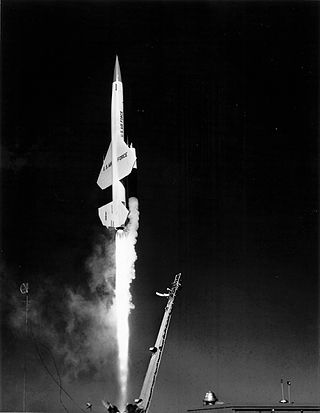
The Boeing CIM-10 Bomarc was a supersonic ramjet powered long-range surface-to-air missile (SAM) used during the Cold War for the air defense of North America. In addition to being the first operational long-range SAM and the first operational pulse doppler aviation radar, it was the only SAM deployed by the United States Air Force.

A surface-to-air missile (SAM), also known as a ground-to-air missile (GTAM) or surface-to-air guided weapon (SAGW), is a missile designed to be launched from the ground to destroy aircraft or other missiles. It is one type of anti-aircraft system; in modern armed forces, missiles have replaced most other forms of dedicated anti-aircraft weapons, with anti-aircraft guns pushed into specialized roles.
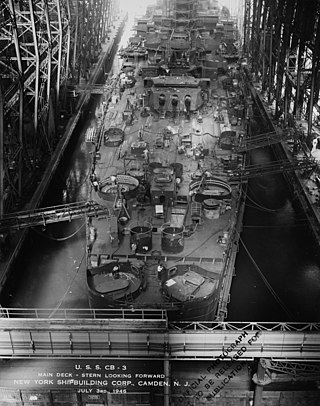
USS Hawaii (CB-3) was intended to be the third member of the Alaska-class large cruisers. It was the first United States Navy ship to be named after the then-Territory of Hawaii. Because Hawaii's construction was delayed by higher-priority ships like aircraft carriers, her keel was not laid until December 1943, about two years after her sister ship Guam.

The Convair RIM-2 Terrier was a two-stage medium-range naval surface-to-air missile (SAM), among the earliest SAMs to equip United States Navy ships. It underwent significant upgrades while in service, starting with beam-riding guidance with a 10-nautical-mile (19 km) range at a speed of Mach 1.8 and ending as a semi-active radar homing (SARH) system with a range of 40 nmi (74 km) at speeds as high as Mach 3. It was replaced in service by the RIM-67 Standard ER (SM-1ER).

The RIM-7 Sea Sparrow is a U.S. ship-borne short-range anti-aircraft and anti-missile weapon system, primarily intended for defense against anti-ship missiles. The system was developed in the early 1960s from the AIM-7 Sparrow air-to-air missile as a lightweight "point-defense" weapon that could be retrofitted to existing ships as quickly as possible, often in place of existing gun-based anti-aircraft weapons. In this incarnation, it was a very simple system guided by a manually aimed radar illuminator.

The AGM-122 Sidearm was an American air-to-surface anti-radiation missile produced between 1986 and 1990. While not as capable as newer anti-radiation missiles, they were cheaper and lighter in weight allowing more versatile deployment.

The General Dynamics RIM-24 Tartar was a medium-range naval surface-to-air missile (SAM), among the earliest SAMs to equip United States Navy ships. The Tartar was the third of the so-called "3 Ts", the three primary SAMs the Navy fielded in the 1960s and 1970s, the others being the RIM-2 Terrier and RIM-8 Talos.

Bendix RIM-8 Talos was a long-range naval surface-to-air missile (SAM), among the earliest SAMs to equip United States Navy ships. The Talos used radar beam riding for guidance to the vicinity of its target, and semi-active radar homing (SARH) for terminal guidance. The four antennas surrounding the nose were SARH receivers, which functioned as a continuous wave interferometer. A solid rocket booster provided thrust for launch and a Bendix ramjet powered its flight to the target, with the warhead serving as the ramjet's compressor.

Topsail Island is a 26-mile (41.8 km) long barrier island off the coast of North Carolina, roughly equidistant between the barrier islands of the Crystal Coast and the beaches of the Cape Fear region, lying south of Jacksonville, North Carolina and Camp Lejeune. The northeastern edge of the island is the New River Inlet, and the southwestern edge is New Topsail Inlet. It is separated from the mainland by a series of small sounds and channels that make up a portion of the Atlantic Intracoastal Waterway.

The RIM-66 Standard MR (SM-1MR/SM-2MR) is a medium-range surface-to-air missile (SAM), with a secondary role as an anti-ship missile, developed for the United States Navy (USN). A member of the Standard Missile family of weapons, the SM-1 was developed as a replacement for the RIM-2 Terrier and RIM-24 Tartar that were deployed in the 1950s on a variety of USN ships. The RIM-67 Standard (SM-1ER/SM-2ER) is an extended range version of this missile with a solid rocket booster stage.

The RIM-67 Standard ER (SM-1ER/SM-2ER) is an extended range surface-to-air missile (SAM) with a secondary anti-ship capability, originally developed for the United States Navy (USN). The RIM-67 was developed as a replacement for the RIM-8 Talos, a 1950s system deployed on a variety of USN ships, and eventually replaced the RIM-2 Terrier as well, since it was of a similar size and fitted existing Terrier launchers and magazines. The RIM-66 Standard MR was essentially the same missile without the booster stage, designed to replace the RIM-24 Tartar. The RIM-66/67 series thus became the US Navy's universal SAM system, hence the designation "Standard Missile".
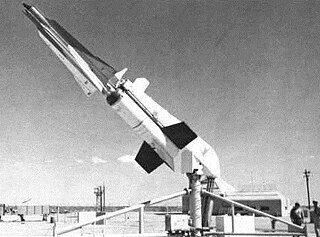
Typhon was a missile system developed by the United States Navy in the late 1950s, intended to serve as an integrated air-defense system for Navy fleets. Consisting of the SAM-N-8 Typhon LR, later designated RIM-50A, and the SAM-N-9 Typhon MR, later RIM-55A, paired with the AN/SPG-59 radar system, the cost of the Typhon system led to it being cancelled in favor of the Standard Missile program.

The Creative Research On Weapons or Crow program was an experimental missile project developed by the United States Navy's Naval Air Missile Test Center during the late 1950s. Intended to evaluate the solid-fueled integral rocket/ramjet (SFIRR) method of propulsion as well as solid-fueled ramjet engines, flight tests were conducted during the early 1960s with mixed success.
The ASM-N-5 Gorgon V was an unpowered air-to-surface missile, developed by the Glenn L. Martin Company during the early 1950s for use by the United States Navy as a chemical weapon delivery vehicle. Developed from the earlier PTV-N-2 Gorgon IV test vehicle, the program was cancelled without any Gorgon Vs seeing service.
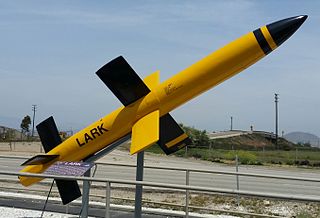
The SAM-N-2 Lark project was a solid-fuel boosted, liquid-fueled surface-to-air missile developed by the United States Navy to meet the kamikaze threat. It was developed as a crash program to introduce a medium-range defensive layer that would attack targets between the long-range combat air patrols and short-range anti-aircraft artillery. This produced a design with roughly 30 miles (48 km) maximum range and subsonic performance, suitable for attacks against Japanese aircraft.

The AAM-N-4 Oriole was an early American air-to-air missile, developed by the Glenn L. Martin Company for the United States Navy. Designed for launch from carrier-based aircraft, the missile programme was cancelled before flight testing began, and the missiles produced were utilized as test vehicles.
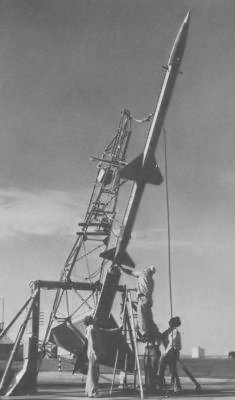
The Ground-to-Air Pilotless Aircraft (GAPA) was a short-range surface-to-air missile (SAM) developed in the late 1940s by Boeing for the United States Army Air Forces, and then the United States Air Force after 1948. It was given the reference number SAM-A-1, the first Surface-to-Air Missile (SAM) in the 1947 tri-service designation system. By 1950, over 100 test rockets had been launched using a variety of configurations and power plants, with one launch in 1949 setting the altitude record for a ramjet powered vehicle at 59,000 ft (18,000 m).
The SSM-N-2 Triton was a supersonic nuclear land-attack cruise missile project for the United States Navy. It was in development from 1946 to 1957, but probably no prototypes were produced or tested. The Triton program was approved in September 1946, designated SSM-2 a year later, and redesignated SSM-N-2 in early 1948. A preliminary design was produced by 1950 as the XSSM-N-2, but was scaled down by 1955 and redesigned again in 1957. Triton was cancelled in 1957, probably as a result of the 1956 decision to focus the Navy's strategic weapons development on the Polaris submarine-launched ballistic missile. In any case, prototypes of the similar Regulus II missile had already flown, and Triton was redundant, offering only an increase in range from 1,000 nautical miles (1,900 km) to 1,500 nautical miles (2,800 km), which Polaris was about to achieve along with many other advantages. Regulus II was itself cancelled in 1958, although testing of missiles already built continued for several years.

The PTV-N-2 Gorgon IV was a subsonic ramjet-powered missile developed by the Glenn L. Martin Company for the United States Navy. Originally intended as an air-to-surface weapon, it materialized as a propulsion test vehicle, and between 1947 and 1950 was used for test purposes and, as the KDM Plover, as a target drone.
















